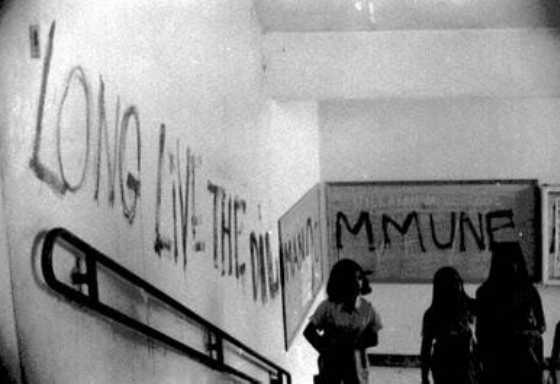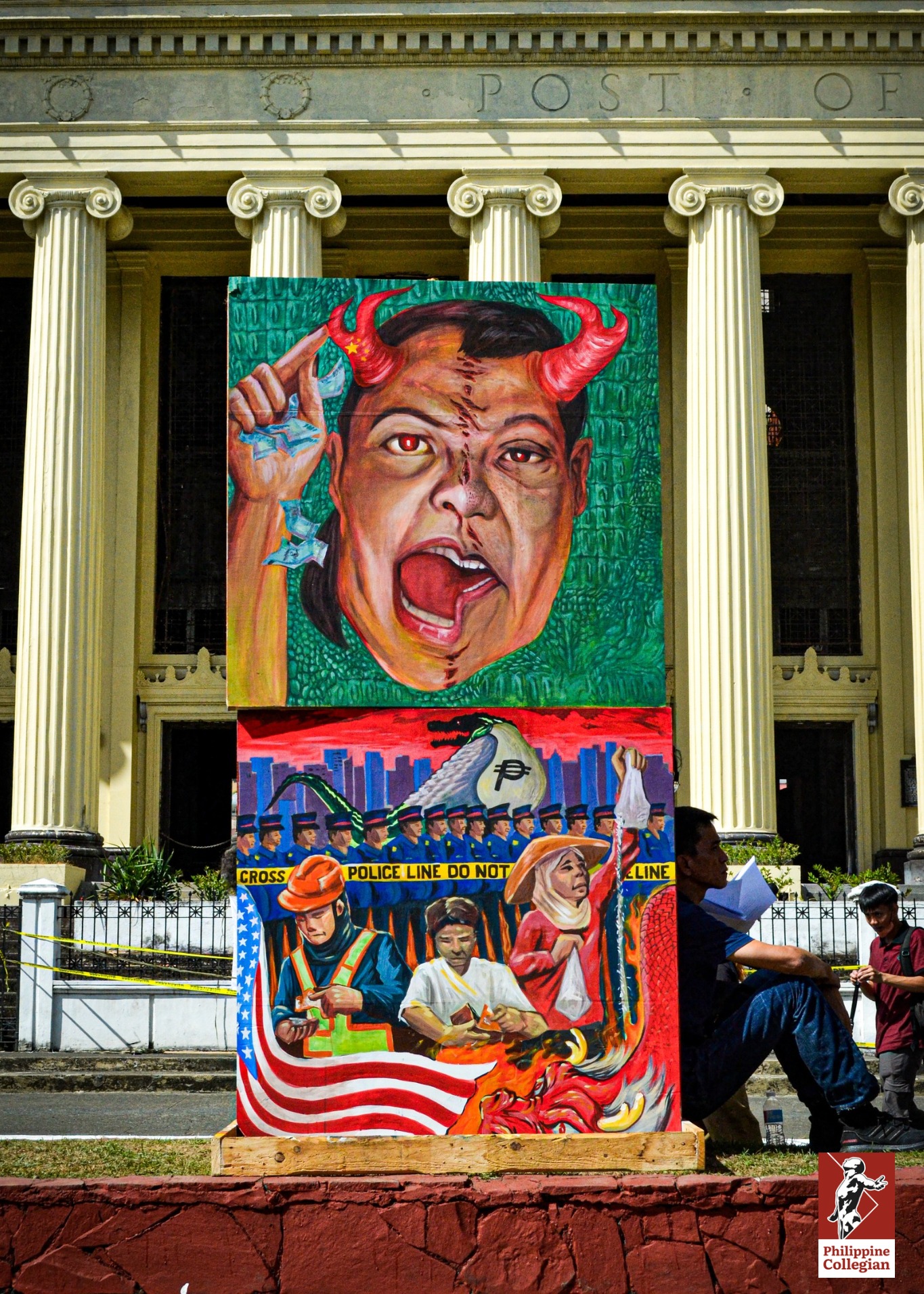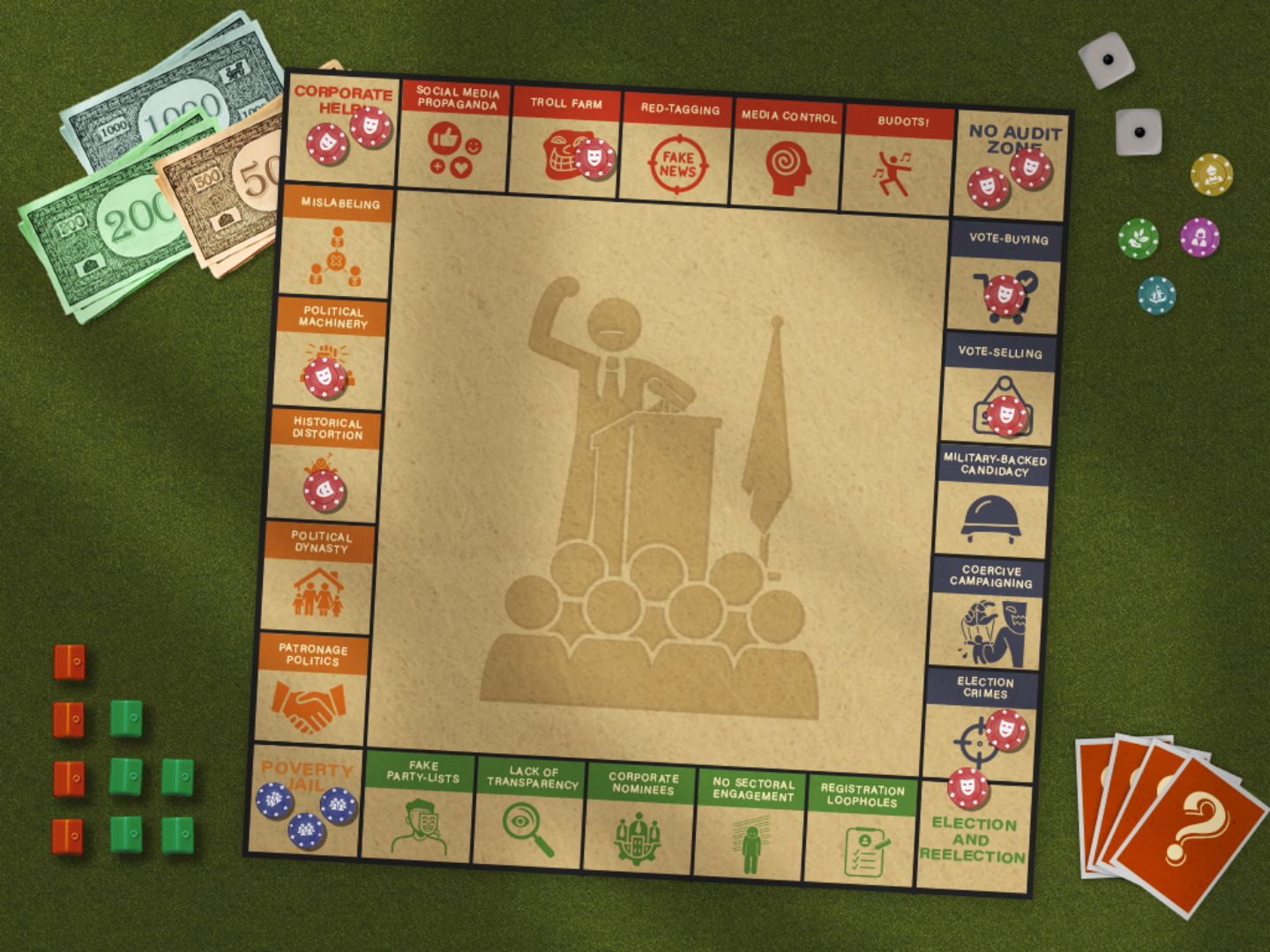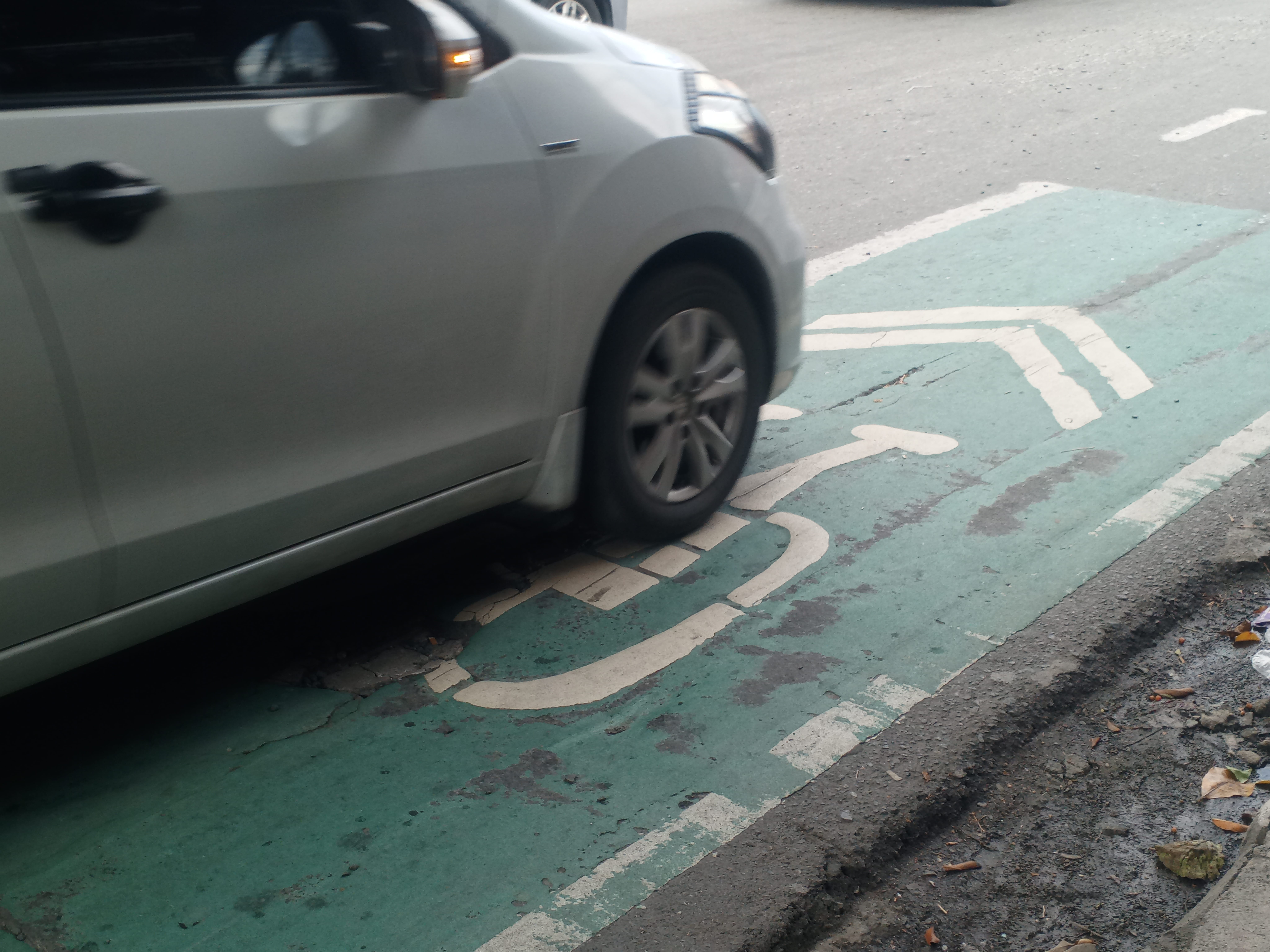By REY B. VEA
The red flags atop AS and Engg have been hoisted down. The red star on the rooftop cubicle of the main library has been erased. Remnants of the nine-day Diliman Commune have been painted over, swept off, and towed away by the local administration.
What remains are the chair-less rooms of AS, the graffiti in the faculty center (Jose Ma. Sison, it says), bullet marks at the Narra Residence Hall (the much-beleaguered first line of defense), broken glass and a bullet hole in the iron gate of the Sampaguita Residence Hall, and perhaps unrecovered shells, stones, and traces of powder on the streets.
Somehow, when one walks past the area between AS and BA near the covered walk leading to the main lib, something seems lacking. In a bus or jeepney, one somehow expected to stop or ram through something at the second gate along the University Avenue, at the crossing between the Jose Ma. Sison Center and the AS and at the bend along the first pavilion. One enters the classroom with an alien feeling and doubt that all normalcy seems artificial. Professors still prate about the same old irrelevant things as if SDK comrade Sonny Mesina’s giving up of his life, Beta Sigman Rey Bello’s bullet wound in his upper right arm, Vanguard Danny Delfin’s confinement at the intensive care room of the VMH, the subpoenas and truncheon marks of many students are being denied of their reality.
One goes to Trialogue, Vinzons only to find that Commander Dante’s left thigh has been hit by a bullet that pierced through a glass window. Of course, it’s only a poster. Of course, they can’t do that to the KUYA. But, then, it’s real lead or copper that half-shattered the window. No amount of bourgeois “fall from the skies” ideas inside the classrooms can deny that.
When one now sips at his Coke or 7-Up, it could simply be a refreshing drink—or it could be an imperialist product and better still, a potential component of a Molotov.
When one sees a kuwitis (the Metrocom knows this anyway), it could mean a Happy New Year’s eve or a fiesta—or it could be a surface-to-air missile (SAM) for state helicopters and piper cubs and a long-range anti-personnel weapon.
Even rocks are not only for a beautiful campus landscape—they are also for barricading and for throwing at fascist brutes.
Arm-chairs and blackboards are no longer for piously taking miseducation lectures in, they are for barricades, too—shields against the bullets of State troopers.
Florence and Erlenmeyer flasks, acids, bases, and soap are not for “pure” scientific study alone. As any progressive Chem major and defender of the barricades would tell us, they could be concocted into something with which to scare away the police.
Fraternities are no longer for petty rumbles—they are effective forces of progress in the University.
*
And indeed, one gets to believe that all normalcy is artificial and temporary. For in this University, as in the national society, there are two conflicting consciousness—two cultures in continuous confrontation, now and then being dramatized and concretized as they are transformed into political forces in the material level. The oil crisis, transport strike, and the Diliman Commune, as well as the many other confrontations between the old and the new, the forces of reaction and progress in the mass actions of the past prove this.
During the Diliman Commune, what prevailed dominant, at least for a time, was the national democratic consciousness—the counter-force against a colonial, feudal and bourgeois individualist and subjectivist culture. With the present seeming dominance of the other in the material plane, the counter-consciousness, that was further enhanced by a recent unprecedented nine-day concrete experience, is not stamped out. If objective conditions so dictate, it can always be transformed into a material force. The university within the University still remains.
*
During the siege of the University, the issue of “academic freedom” was brought up. Although it had then rallied a number of people to the cause, there is the need of placing the physical invasion of UP in its proper context.
Academic freedom, just like the slogan of individual freedom, is a liberal concept that does not correctly reflect social realities. With antagonistic social forces interlocked in intense struggle, as perceptual experiences would show, no individual and no institution could with the passage of time remain neutral. It is either a partisan for the masses or a tool of the ruling class. Whatever semblance of academic freedom there is in campus is merely due to the incompleteness of the imminent polarization of forces.
There have been instances when academic freedom has been proven to be a cloak for inherent reaction. When Ramon Sanchez and other progressive instructors were kicked out of the University; when the graduation of Sixto Carlos Jr., Ellecer Cortes, and Monico Atienza was withheld due to their draping of the Oblation; when the film “East is Red” was raided—where was the freedom of the academe. There was freedom for the reactionaries, but not for the progressives.
It would be incorrect to place the University as a whole, without due cognizance of the opposing forces in campus, in contraposition to the State. If the State forces had intruded and occupied the Academe, as necessitated by the strength of the national democratic forces in the academe and the “weakness” of a liberal administration, we could be pretty sure that the freedom of reactionary professors, students won’t be trampled upon. In fact, there are those scabs among the faculty and the studentry who won’t hesitate to suggest that the Metrocom and police come in to rid the University of radical and liberal elements.
What could be more apt is to view the physical intrusion of the fascist State into the University in the context of the broad suppression of the democratic rights of progressive classes in society. It is basically no different when the State apparatus is brought to bear on striking workers and progressive peasants.
*
The impotence of the liberal Lopez administration in meeting squarely the threat of State intrusion into the University has been betrayed by the Diliman crisis. His own offer to resign on February 9 is an indication of this, aside from the many inconsequential dialogues he had with the officers of State forces, Amoranto, Enrile, Melchor, and Abad Santos.
The support which the students accorded him during the middle of the Commune, notwithstanding his moral responsibility for the killing of Pastor Mesina by Campos and his command responsibility for the shooting spree done by the UP Security Force, it seems has been taken in bad faith.
The masses of students suspect, and not without reason, that President Lopez is behind the so-called “Third Force” which aims at beclouding the issue of gasoline and oil by pegging it to the barricade issue without explaining the relationship of the two and without giving any clear alternative form of protest despite their avowed support of the issue of the drivers. This force also aims at appealing to and exploiting the individualist tendencies of residents to heat up antagonism between the barricaders and the other constituents in an effort to divide and rule. The necessity of inconvenience was not explained despite their token belief in the issue.
This force has in its ranks reactionary faculty members and students, who have time to worry about their individual comfort as if the raising of prices of oil and gasoline were not a big discomfort to the Filipino masses. It is ironic that this group counts on the support of mostly vehicle-owning constituents. Those who had to work from Butterfly restaurant to Balara, Area 11, Area 5, and Krus na Ligas, even as this group could already drive into their comfortable homes, are the ones who don’t complain.
Among the students, there are those who carry the line of the Marcos administration and Lopez. Naturally, they have the favor of their masters. So, on February 8, the microphone given to the masses of students in front of AS was so weak that the megaphone had to be resorted to. Puno and his gang were given a sound system that could be heard from the administration building to the site of the barricades where protest classes were being held.
The agreement made on February 8 was violated. We came into the University the morning of the next day and saw personnel from the physical plant office, “under orders” hauling away the barricades along the University Avenue. The agreement was that it was merely to be set aside. Buses by then were entering the University. When questioned, drivers said that the Security Force had told them to do so. When we requested for the shuttle bus to transport those who, unlike the third force, have no cars, we were not given any despite their previous promise. We requested them to stay by us in the human barricade, but they left shortly before twelve noon, the time when the police were supposed to come in. Which just goes to show what characters they really are.
You have given us a lesson of your duplicity and yellow “commitment” and we shall be wiser by it. ●
First published in print on February 18, 1971.







